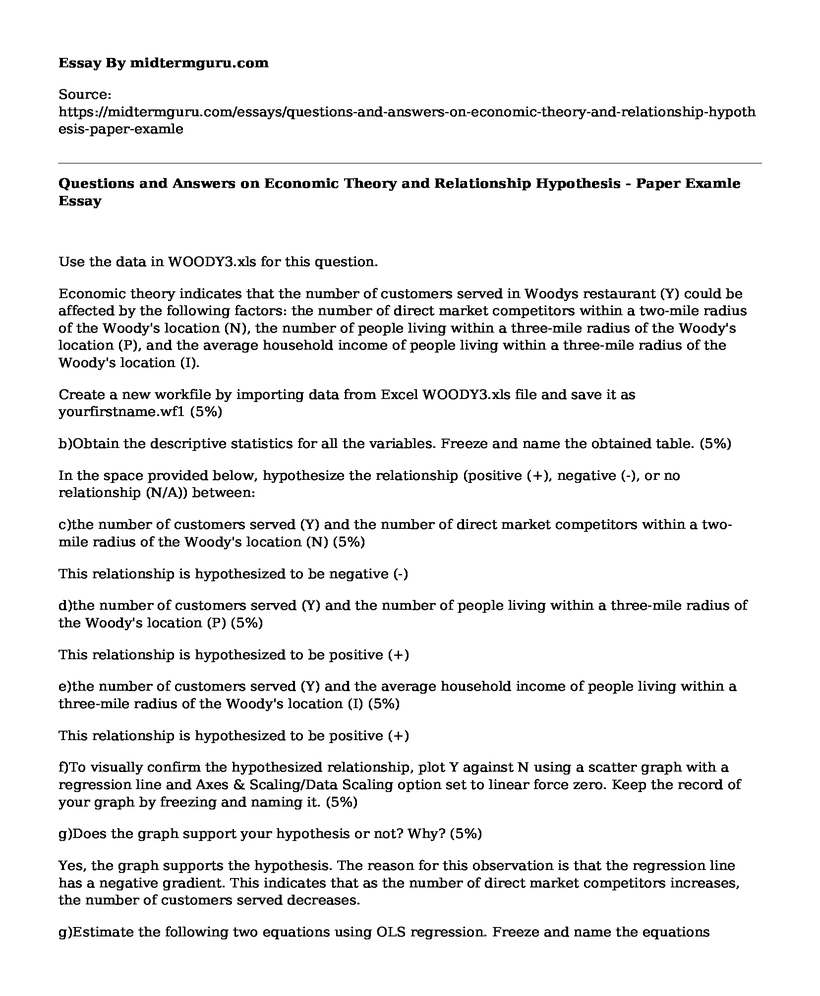Use the data in WOODY3.xls for this question.
Economic theory indicates that the number of customers served in Woodys restaurant (Y) could be affected by the following factors: the number of direct market competitors within a two-mile radius of the Woody's location (N), the number of people living within a three-mile radius of the Woody's location (P), and the average household income of people living within a three-mile radius of the Woody's location (I).
Create a new workfile by importing data from Excel WOODY3.xls file and save it as yourfirstname.wf1 (5%)
b)Obtain the descriptive statistics for all the variables. Freeze and name the obtained table. (5%)
In the space provided below, hypothesize the relationship (positive (+), negative (-), or no relationship (N/A)) between:
c)the number of customers served (Y) and the number of direct market competitors within a two-mile radius of the Woody's location (N) (5%)
This relationship is hypothesized to be negative (-)
d)the number of customers served (Y) and the number of people living within a three-mile radius of the Woody's location (P) (5%)
This relationship is hypothesized to be positive (+)
e)the number of customers served (Y) and the average household income of people living within a three-mile radius of the Woody's location (I) (5%)
This relationship is hypothesized to be positive (+)
f)To visually confirm the hypothesized relationship, plot Y against N using a scatter graph with a regression line and Axes & Scaling/Data Scaling option set to linear force zero. Keep the record of your graph by freezing and naming it. (5%)
g)Does the graph support your hypothesis or not? Why? (5%)
Yes, the graph supports the hypothesis. The reason for this observation is that the regression line has a negative gradient. This indicates that as the number of direct market competitors increases, the number of customers served decreases.
g)Estimate the following two equations using OLS regression. Freeze and name the equations results. (5%)
Yi = b1 + b2 Ni + b3 Pi + b4 Ii + ui (1)
lnYi = b1 + b2 lnNi + b3 lnPi + b4 lnIi + ui (2)
h)Report the results from equation (2) with 3 decimal points in the following table. (10%)
Equation (2)
Variable Coefficient Std error t-stat p-value
constant 6.875 0.884 7.773 0.000
lnN-0.344 0.079 -4.352 0.000
lnP0.333 0.063 5.250 0.000
lnI0.155 0.097 1.530 0.125
i)Which of the estimated coefficients (excluding constant term) are statistically significant at 5% level? Why? (5%)
The estimated coefficients that are statistically significant (excluding constant term) are lnN and lnP. The main reason for this is that the p-value is less than 0.05; hence, we can reject the null hypothesis indicating that the coefficient is not significant.
j)Interpret the estimated coefficients of lnP and lnI in equation (2). (10%)
Based on the estimated coefficients of lnP and lnl the estimated coefficient can be interpreted as follows. A 1-unit increase in lnP will lead to a 0.33 (33%) increase in lnY holding all other variables constant. On the other hand, a 1-unit increase in lnl will lead to a 0.155 (15.5%) increase in lnY holding all other variables constant.
k)Report the confidence intervals for b2 at 90% and 99%? (5%)
The confidence interval for b2 at 90% and 99% are as shown in the table below.
Variable Coefficient 90% CI 99% CI
Low High Low High
lnN-0.344 -0.480 -0.208 -0.568 -0.120
l)At which confidence intervals (90% or 99%) the range in higher and why? (10%)
The range is higher at the 0.99% interval. The range at the 90% CI is 0.272 while at the 99% CI it is 0.448. The main reason for this is that the 99% confidence interval increases confidence of the interval actually containing the population mean by reducing the precision. On the other hand, reducing precision is achieved by increasing the range. This is as compared to the 90% CI that has higher precision by having a smaller range.
n)What is the meaning of r-square in equation (2)? (10%)
The r-square in the equation refers to the proportion of the dependent variable that can be predicted by the independent variables. In the case of equation 2, 69.5% of the dependent variable (the number of customers served in Woodys restaurant) can be explained by the independent variable (lnN, lnP, and lnI) included in the equation.
m)Why most researchers automatically use adjusted r-square instead of r-square when evaluating the fit of their estimated regressions equations? (10%)
Most researchers automatically use adjusted r-square since it takes into account the number of independent variables (predictors) included in the estimation model. This is advantageous since R-squared increases with an increase in the number of independent variables at all times, on the other hand, adjusted R-squared increase only if an increase in the number of independent variables has a significant impact on the model. Hence, we can conclude that the adjusted R-square is mainly used because it provides an accurate overview of the regression model.
Cite this page
Questions and Answers on Economic Theory and Relationship Hypothesis - Paper Examle. (2021, Jun 25). Retrieved from https://midtermguru.com/essays/questions-and-answers-on-economic-theory-and-relationship-hypothesis-paper-examle
If you are the original author of this essay and no longer wish to have it published on the midtermguru.com website, please click below to request its removal:
- Essay on Three Dimensions of Productive Paranoia
- Discussion Questions on Human-Machine Interface (HMI) - Paper Example
- Brief Summary of the Organization: The World Food Program USA
- The Role of the HRD and How It Contributes to the Organization's Strategic Goals - Paper Example
- Paper Example on Organization Culture of Two Birds Apparel Company
- Attracting and Retaining Top Talent: The Power of Incentives - Essay Sample
- Organizational Behavior: Key to Corporate Advantage - Essay Sample







